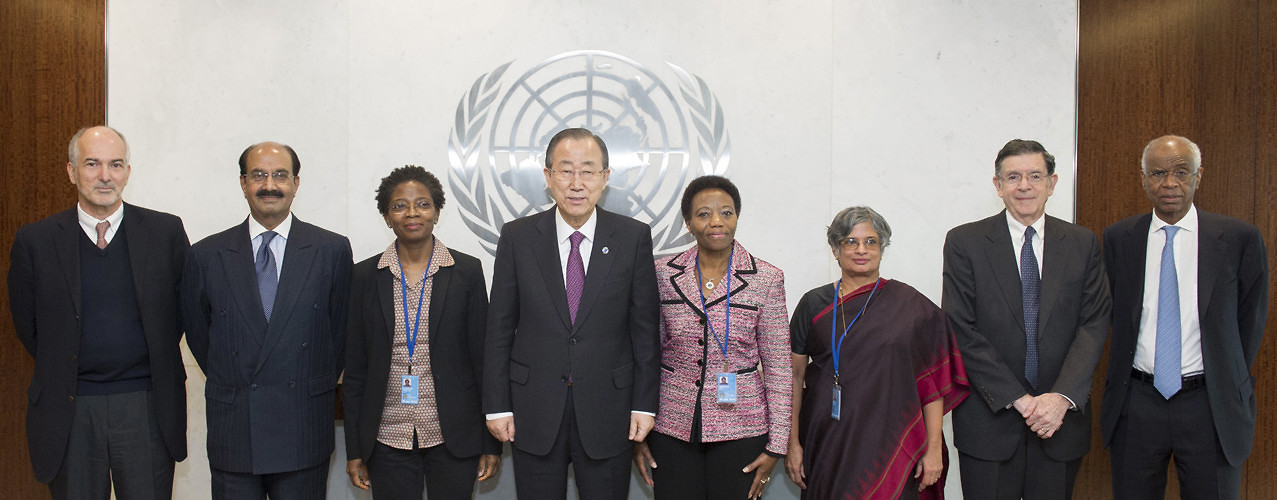Gert Rosenthal (second from right) with other members of the UN peacebuilding panel of experts and Secretary General Ban Ki-moon (center). New York, February 12, 2015. (UN Photo/Mark Garten)
In the United Nations’ quest for peace, the decision to create the Peacebuilding Commission, the Peacebuilding Support Office (PBSO), and the Peacebuilding Fund in 2005 was hailed as a significant achievement. However, five years later, the first review of this peacebuilding architecture was characterized as one of unrealized hopes. Recommendations were made to fill in the gaps, but by 2015, hopes had further diminished, according to recent surveys.
In 2015, a new in-depth review was undertaken, based on specific terms of reference approved by both the General Assembly and the Security Council. This review [to be discussed in a live webcast from the International Peace Institute today] covered not just the entities above but the UN system as a whole, and had two phases. First, an independent advisory group (of which I served as chair) was tasked to prepare its own assessment and recommendations. A second intergovernmental phase would follow to translate the recommendations of the advisory group into consensual policy decisions aimed at improving the UN’s performance in peacebuilding.
The first phase of the review has now concluded. What are the main, overarching findings of the report? First, it takes issue with the way peacebuilding is commonly understood, as an activity undertaken only in post-conflict situations—in fact, the agenda item of the Security Council on the matter is still called “post-conflict peacebuilding.” This understanding poses several difficulties. The most important one is that it collides with reality, since peacebuilding actually occurs or can occur during all phases of the conflict cycle: before, during, and after. This is a fact that the Security Council itself recognized as early as 2001, but does not seem to assimilate into its decision-making.
The real world also collides with the notion that UN interventions in the peace and security sphere have some sort of sequencing, whereby if preventive measures fail, peacemaking and peacekeeping follow, and, when the guns fall silent, attention is focused on peacebuilding. This type of tidy sequencing is wrong conceptually and in operational terms. In addition, the mindset that comes with the prior two notions relegates peacebuilding to a relatively peripheral activity, since ending the conflict always takes priority, while peacebuilding can wait until the fire is extinguished. What seems to be lost from sight is that proper peacebuilding interventions can avoid conflict in the first place. In fact, and second, the report stresses the importance of making greater use of conflict prevention in the Security Council’s toolbox of interventions.
The third overarching conclusion is related to the institutional and organizational implications of this major misinterpretation of how peacebuilding should be conceived. The Security Council is mandated to maintain international peace and security, but it also is the principal organ involved in UN peacebuilding. However, it is rarely perceived in those terms; indeed, most members of the Council do not perceive themselves as peacebuilders, in spite of the fact that virtually all peace operation resolutions are loaded with classic peacebuilding functions: statebuilding, institution building, capacity building, and promoting the rule of law. But part of those activities, and especially the development aspects, also falls within the purview of the UN General Assembly and the Economic and Social Council.
While the Peacebuilding Commission, an advisory body, has had the potential to bridge the activities of the three principal intergovernmental organs, it has not been able to do so in an effective manner, given the fragmentation of the UN into separate “silos,” coupled with the limited capacity of its PBSO. In other words, the Peacebuilding Commission can only be effective if the other principal organs accept working with it in a partnership mode, something that has not happened, except on rare occasions—one of these was the creation of the UN Integrated Peacebuilding Office in Sierra Leone. So, the challenges faced by the peacebuilding architecture are not limited to the entities created in 2005; rather, they are systemic in nature.
Further, the fragmentation observed at the intergovernmental level is mirrored in the internal distribution of responsibilities between the different departments of the Secretariat, between the Secretariat and the rest of the UN system, and in the UN presence on the ground, where it impacts the most. Indeed, the fourth overarching conclusion is that excessive attention is paid to examining peacebuilding interventions at UN headquarters, rather than in the country setting where peacebuilding actually takes place.
Fifth, it is the domestic stakeholders that are the primary actors that need to reach a common understanding on how to accommodate different views and interests without recurring to violence. Local ownership is indispensable: the report labels it “inclusive national ownership” and frames it as a process that must be forged between the state and all sectors of civil society in order to ensure that peace becomes sustainable. It suggests that the UN can play an important enabling role in the above endeavor, but it cannot lead.
In addition, it will never be the only external actor, and often not even the main external actor. It will therefore, in the sixth place, have to improve its capacity to partner with other multilateral and regional organizations, as well as with domestic stakeholders.
Finally, a commitment to peacebuilding involves two additional ingredients: predictable long-term financing and perseverance. On the first aspect, the Peacebuilding Fund has played a catalytic role in helping to mobilize additional resources, and this role should be strengthened. On the second, developing solid institutions of governance and capacities to promote development requires timelines expressed not in years, but in decades. The UN must therefore be prepared to be involved in peacebuilding activities “for the long haul.”
Gert Rosenthal is former Permanent Representative of Guatemala to the United Nations, and chair of the advisory group reviewing the UN peacebuilding architecture.





